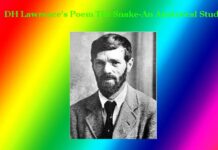The Theme of Pain and Sufferance in the Poetry of Emily Dickinson
The Theme of Pain and Sufferance in the Poetry of Emily Dickinson
The Theme of Pain and Sufferance in the Poetry of Emily Dickinson
Miss Emily Dickinson (1830-1886), one of the great poetesses of America, wrote poetry on a variety of themes; but almost all her poems are the utterance of a forlorn, crest-fallen, desperate soul and through the poems, she poured down her sorrows, pain and sufferance that she faced and felt in life. And in doing so, she has thrown her discriminating eyes on the nature of pain—its stages, its effects on the human soul and finally the relation of pain with death and God. A study of her poems shows that throughout her life she nursed in her heart, a deep source of hidden pain, and suffering caused by the despair of her personal life. But all the pain and sufferance she bore always with herself under suppression, which grew out bit by bit in her poetry. But what were the causes of her despair that caused her to suffer in life? To get a proper reply, we must look back at her personal life. In her childhood, she seemed to be an active sprightly humorous girl. But with the passing of years, she became internally gloomy, melancholic, and home-sick and took to leading a secluded life keeping away from the outward social world. The causes of her change were perhaps, the death of her parents, the disappointment in love affairs and her inclination to literary persuasion. In 1878, when Emily was thirty-seven years old, she lost her father and her mother became paralyzed a year later. The death of her father gave her a shock and this shock was multiplied after seven years of her father’s death, her mother died leaving the family without a guardian. Already she had gone into contact with some male friends with whom she fell in love. Amongst them, Benjamin Newton was one. He encouraged her to take to poetry-writing and studying. But in 1853 he died suddenly which slacked her spirit. A year later of that event, she met Charles Wordsworth, a married clergyman and thought him to be her lover. They also exchanged letters. But he also forsook her. Later on, she made friends with Otis P. Lord and fell passionately in love with him. It is a matter of regret that none of her lovers married her, and she also gave no proposal of marriage to anyone of them. As a result, she remained unmarried throughout her life. All these cases, perhaps, had broken the spirit of her heart and she became desperate. The despairs caused by these events begot pain in her which got reflected in her poems. But she had never cursed pain in life. Instead, she took the pain as a touchtone for estimating the depth of the human soul. Her outlook on pain and suffering was that pain humanized the human soul and it was necessary to have a better life after death. Now let us examine her poems as below:
In the poem ‘I Never Lost as Much but Twice’, she makes a reference to the loss of Benjamin Newton and Charles Wordsworth whom she thought to be her would-be life companions. The loss of them caused despair in her heart and she stood at the door of God as a beggar to get back her lovers, but God showed no sympathy to her. Hence she says satirically.
‘I never lost as much but twice
And that was in the sod.
Twice have I stood a beggar
Before the door of God.
Angels—Twice descending
Reimbursed my store—
Burglar—Banker—Father!
I am poor once more!’
Pain is needed to feel the significance of joy and pleasure. In the poem ‘Success is Counted Sweetest’, she expresses this view metaphorically as—
‘Success is counted sweetest
By those who never succeeded
To comprehend a water
Requires sorest need.’
Despair haunts her throughout her life. Being weary of despair, she desires to take shelter in God, but God also disappoints her. She says in the poem ‘Just Lost When I was Saved’, as—
‘Just lost, when I was saved!
Just felt the world go by!
Just girt me for the onset with Eternity.’
‘Certain Slant of Light’ is a poem in which she exhibits that pain and suffering are sent by heaven to the human soul. None can get rid of it. It is only death that can make an end to suffering. In this poem, the poetess shows the nature of pain caused by despair in the earthly matter. She says:
‘There’s certain slant of light
Winter Afternoon—
That oppresses like the Heft
Of Cathedral Tunes.
Heavenly hurt it gives as—
We can find no scar,
…………………….
…………………….
None may teach it—Any—
‘Tis the Seal Despair—
An imperial affliction
Sent us of the Air—’
The poetess was so overwhelmed by pain that she often imagined the shadow of death was in front of her and often she ‘felt funeral’ in her mind. By the word ‘funeral, she wants to show how deep the pain that caused her suffering. In the poem ‘I felt a Funeral in My Brain’, she says:
‘I felt a Funeral in my brain,
And Mourners to and fro
………………………….
……………………………
And Being but an ear
And I silence, some strange Race
Wrecked, Solitary here—’
To those who are strong enough, experiencing pain is necessary which strengthens the spirit of the soul and teaches how to face the reality of life with much vigour. But the pain that a human soul suffers is deadly. The poetess says:
‘After great pain, a formal feeling comes—
The Nerves sit ceremonious, like Tombs—
…………………………………………….
This is the Hour of Lead—
Remembered if outlived,
As freezing persons, recollect the snow—
First—Chill—then stupor—then the letting go—’
‘My Life Closed Twice Before Its Close’, is a poem that may be interpreted in the light of her personal despair gotten from love when she lost her would-be life partners—Benjamin Newton and Charles Wordsworth. The death of them was like the death of herself. She says:
‘My life closed twice before its close—
It yet remains to see.
If Immortality unveil
A third event to me.
So huge, so hopeless to conceive
As these that twice befell
Parting is all we know of heaven
And we all need of hell.’
From the above discussion, it comes visible that Emily Dickinson led a life loaded with despair, and frustration that caused her suffering and almost all her poems bear the stamp of what had happened to her private life. 0 0 0
The Theme of Pain and Sufferance in the Poetry of Emily Dickinson
Read More: The Theme of Love in the Poetry of Emily Dickinson
The Theme of Pain and Sufferance in the Poetry of Emily Dickinson
N. B. This article entitled ‘The Theme of Pain and Sufferance in the Poetry of Emily Dickinson’ originally belongs to the book ‘Emily Dickinson’s Poetry: A Thematic Study‘ by Menonim Menonimus. The Theme of Pain and Sufferance in the Poetry of Emily Dickinson
The Theme of Pain and Sufferance in the Poetry of Emily Dickinson
Books of Literary Criticism by M. Menonimus:
- World Short Story Criticism
- World Poetry Criticism
- World Drama Criticism
- World Novel Criticism
- World Essay Criticism
- Indian English Poetry Criticism
- Indian English Poets and Poetry Chief Features
- Emily Dickinson’s Poetry-A Thematic Study
- Walt Whitman’s Poetry-A Thematic Study
- Critical Essays on English Poetry
- Tawfiq al-Hakim’s Novel: Return of the Spirit-An Analytical Study
- Tawfiq al-Hakim’s Novel: ‘Yawmiyyat Naib Fil Arayaf’-An Analytical Study
- Analytical Studies of Some Arabic Short Stories
- A Brief History of Arabic Literature: Pre-Islamic Period …
Related Searches:
- Pain as a Theme in Emily Dickinson’s Poetry
- Emily Dickinson as a Poet of Nature
- Theme of Death in the Poetry of Emily Dickinson
- Concept of Death in the Poetry of Emily Dickinson
- Mysticism of Emily Dickinson
- Mysticism in the Poetry of Emily Dickinson
- Emily Dickinson Biography
- Emily Dickinson-Poetry Foundation
- Emily Dickinson’s Collected Poems Themes
- Major Themes of Emily Dickinson’s Poetry
- Emily Dickinson: Poems and Poetry Analysis











